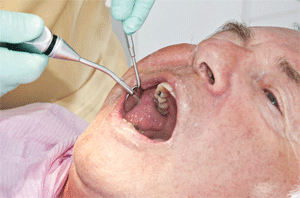 Q: With clear corneal incisions and full-thickness transplants, what are the standard recommendations for dental procedures before or after cataract surgery or corneal procedures?
Q: With clear corneal incisions and full-thickness transplants, what are the standard recommendations for dental procedures before or after cataract surgery or corneal procedures?
A: Dental work and cataract surgeries have a long history, dating back to 1964 when Charles Kelman, M.D., first had the idea of using phacoemulsification for outpatient cataract procedures while sitting in his dentist’s chair getting his teeth cleaned.1
“In fact, the original phacoemulsification device was the Kelman-Cavitron,” says Eric Donnenfeld, M.D., of Rockville Centre, N.Y. “Cavitron was a dental company.”
Today, our teeth and eyes continue to coexist peacefully; still, some ophthalmic surgeons suggest waiting a week or two after cataract surgery or corneal procedures to schedule dental work.
“My concern would be contamination from the dental work causing direct bacterial contamination of the ocular surface,” Dr. Donnenfeld says. Although rare, “dental abscesses can be associated with orbital infections. For this reason, it seems reasonable to wait for the corneal incisions to close.”
Compared to the eye, the mouth is one of the “dirtiest” areas of the body. More than 500 different species of bacteria are found in the human mouth.2
Nevertheless, Thomas Edward Clinch, M.D., of Chevy Chase, Md., believes there is little to no risk of infection from dental work scheduled around standard cataract surgery.
Dr. Clinch recalls only one case of a patient contracting endophthalmitis a week after cataract surgery. After culturing the organism, the doctors were able to conclude that the infection stemmed from a dental procedure.
“It was more coincidence than anything,” he says. “Nasty bugs are released every day, week and month. To get endophthalmitis from a dental procedure is extraordinarily rare.”3
Corneal Transplant

The likelihood that dental work will cause ocular infection or corneal graft mishap is slim--but why take the chance?
However, Dr. Clinch says, patients who undergo a full-thickness corneal transplant should take extra precautions to prevent the dentist from pressing on the eye. He suggests that the patient wear an eye shield at the time of dental procedures to protect the eye from any inadvertent slip that might harm corneal sutures.
“The likeliness of something like that happening is slim, but why take the chance?” he says.
Christopher J. Rapuano, M.D., of Philadelphia, adds that in cases of corneal transplants, dental surgery can stimulate the immune system and cause localized inflammation, which might increase the chance of graft rejection.
“Some corneal surgeons will increase steroid doses for a week before surgery and taper off a few weeks after surgery, or have patients come in a week after to make sure no rejection goes on,” he says.
In all cases, patients should be reminded of the signs of rejection, which include symptoms of pain, photophobia or decreased vision, and signs of redness, edema, anterior chamber reaction or elevated intraocular pressure.
While there are no formal guidelines, spreading out medical procedures is often a good idea. “If the work is elective, I would suggest that the dental work be done first,” Dr. Donnenfeld says.
1. Goldstein JL. How a jolt and a bolt in a dentist’s chair revolutionized cataract surgery. Nat Med. 2004 Oct;10(10):1032-3.
2. Paster BJ, Boches SK, Galvin JL, et al. Bacterial diversity in human subgingival plaque. J Bacteriol. 2001 Jun;183(12):3770-83.
3. Tsai TH, Yang CH, Yang CM, Chen MS. Endogenous endophthalmitis with subretinal abscess after dental procedures. J Formos Med Assoc. 2005 Jan;104(1):47-9.

